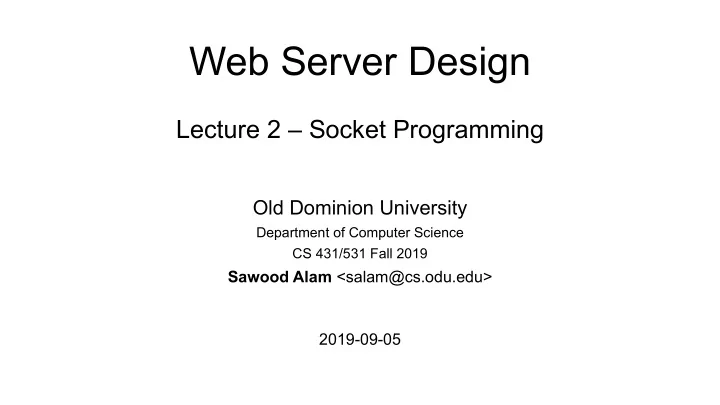

Web Server Design Lecture 2 – Socket Programming Old Dominion University Department of Computer Science CS 431/531 Fall 2019 Sawood Alam <salam@cs.odu.edu> 2019-09-05
Interprocess Communication (IPC) • File • Shared memory • Memory-mapped file • Message passing • Pipe • Message queue • Signal • Unix socket • Network socket
Network Socket Workflow Create a server socket Create a client socket Bind to a network interface and port Listen for client connections [LOOP] Connect to the server socket Accept an incoming connection Receive/Send data [LOOP] Send/Receive data [LOOP] Shutdown (notify connected client) Shutdown (notify connected server) Close the connection Close the connection
Host and Port ● Host ○ An IP address (IPv4 or IPv6) ○ A domain name mapped to an IP address ○ Identifies a host/machine on a network ● Port ○ A number from 0 to 65535 ○ 0-1023 ranges is reserved (needs privileged access) ○ Identifies a process on a host for socket communication ○ Not every process is bound to a port
Common Default Port Numbers Port Number Service 20/21 File Transfer Protocol (FTP) 22 Secure Shell (SSH) 23 Telnet 25 Simple Mail Transfer Protocol (SMTP) 53 Domain Name System (DNS) 80 Hypertext Transfer Protocol (HTTP) 110 Post Office Protocol (POP3) 123 Network Time Protocol (NTP) 143 Internet Message Access Protocol (IMAP) 194 Internet Relay Chat (IRC) 443 HTTP Secure (HTTPS) https://en.wikipedia.org/wiki/Port_(computer_networking)
Network Interfaces $ host cs531.cs.odu.edu 1. Loopback cs531.cs.odu.edu has address 128.82.7.233 2. Public $ ssh cs531.cs.odu.edu 3. Private $ host localhost localhost has address 127.0.0.1 $ ip -4 a 1: lo: <LOOPBACK,UP,LOWER_UP> mtu 65536 qdisc noqueue state UNKNOWN group default qlen 1000 inet 127.0.0.1 /8 scope host lo valid_lft forever preferred_lft forever 2: ens160: <BROADCAST,MULTICAST,UP,LOWER_UP> mtu 1500 qdisc mq state UP group default qlen 1000 inet 128.82.7.233 /24 brd 128.82.7.255 scope global ens160 valid_lft forever preferred_lft forever 3: docker0: <NO-CARRIER,BROADCAST,MULTICAST,UP> mtu 1500 qdisc noqueue state DOWN group default inet 172.17.0.1 /16 brd 172.17.255.255 scope global docker0 valid_lft forever preferred_lft forever
Loopback Address: localhost $ cat /etc/hosts 127.0.0.1 localhost.localdomain localhost # The following lines are desirable for IPv6 capable hosts ::1 localhost6.localdomain6 localhost6 ::1 localhost ip6-localhost ip6-loopback
127.0.0.1 vs. 0.0.0.0 ● 127.0.0.1 (or localhost) ○ Listening on loopback interface only (unless tunneled) ● 0.0.0.0 ○ Listening on all network interfaces ○ Not a resolvable address Processes running in Docker containers listening on loopback interface will not be accessible from outside of the container, run them on 0.0.0.0 instead.
Hello Server: Python #!/usr/bin/env python3 import socket HOST = "0.0.0.0" PORT = 8080 s = socket.socket(socket.AF_INET, socket.SOCK_STREAM) s.setsockopt(socket.SOL_SOCKET, socket.SO_REUSEADDR, 1) s.bind((HOST, PORT)) s.listen() print(f"Listening on {HOST}:{PORT} for HTTP connections") while True: conn, addr = s.accept() print(f"Connected to {addr}") conn.sendall(b"Hello from server\n") conn.close()
Hello Server: Ruby #!/usr/bin/env ruby require "socket" host = "0.0.0.0" port = 8080 socket = TCPServer.new(host, port) puts "Listening on #{host}:#{port} for HTTP connections") loop do client = socket.accept puts "Connected to #{client}" client.write("Hello from server\n") client.close end
Concurrency #!/usr/bin/env ruby require "socket" host = "0.0.0.0" port = 8080 socket = TCPServer.new(host, port) puts "Listening on #{host}:#{port} for HTTP connections") loop do Thread.start(socket.accept) do |client| puts "Connected to #{client}" client.write("Hello from server\n") client.close end end
Run the Hello Server $ ./server.py Listening on 0.0.0.0:8080 for HTTP connections Connected to ('127.0.0.1', 46930) $ telnet localhost 8080 Trying 127.0.0.1... Connected to localhost. Escape character is '^]'. Hello from server Connection closed by foreign host.
Recommend
More recommend